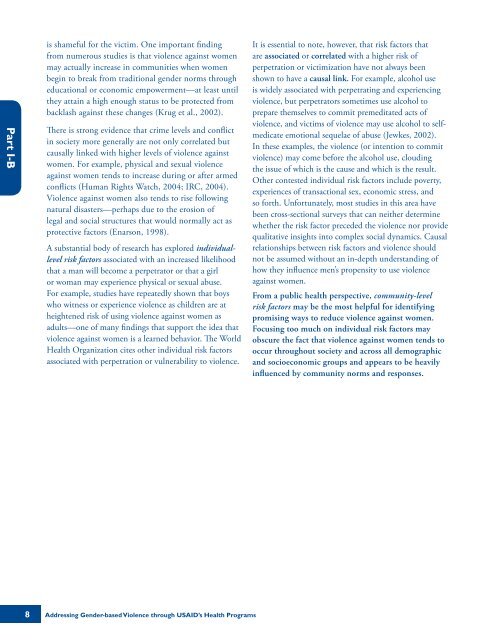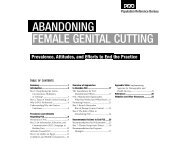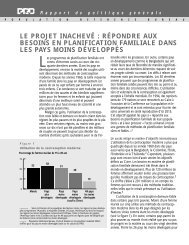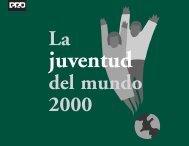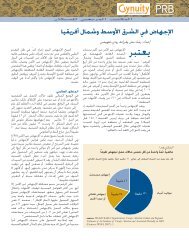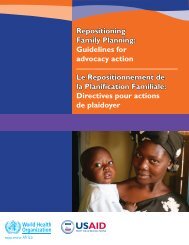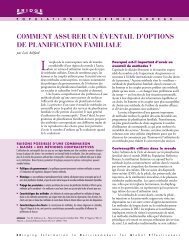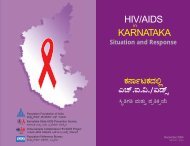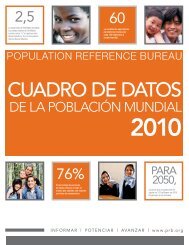addressing gender-based violence through usaid's health ... - IGWG
addressing gender-based violence through usaid's health ... - IGWG
addressing gender-based violence through usaid's health ... - IGWG
Create successful ePaper yourself
Turn your PDF publications into a flip-book with our unique Google optimized e-Paper software.
Part I-B<br />
is shameful for the victim. One important finding<br />
from numerous studies is that <strong>violence</strong> against women<br />
may actually increase in communities when women<br />
begin to break from traditional <strong>gender</strong> norms <strong>through</strong><br />
educational or economic empowerment—at least until<br />
they attain a high enough status to be protected from<br />
backlash against these changes (Krug et al., 2002).<br />
There is strong evidence that crime levels and conflict<br />
in society more generally are not only correlated but<br />
causally linked with higher levels of <strong>violence</strong> against<br />
women. For example, physical and sexual <strong>violence</strong><br />
against women tends to increase during or after armed<br />
conflicts (Human Rights Watch, 2004; IRC, 2004).<br />
Violence against women also tends to rise following<br />
natural disasters—perhaps due to the erosion of<br />
legal and social structures that would normally act as<br />
protective factors (Enarson, 1998).<br />
A substantial body of research has explored individuallevel<br />
risk factors associated with an increased likelihood<br />
that a man will become a perpetrator or that a girl<br />
or woman may experience physical or sexual abuse.<br />
For example, studies have repeatedly shown that boys<br />
who witness or experience <strong>violence</strong> as children are at<br />
heightened risk of using <strong>violence</strong> against women as<br />
adults—one of many findings that support the idea that<br />
<strong>violence</strong> against women is a learned behavior. The World<br />
Health Organization cites other individual risk factors<br />
associated with perpetration or vulnerability to <strong>violence</strong>.<br />
It is essential to note, however, that risk factors that<br />
are associated or correlated with a higher risk of<br />
perpetration or victimization have not always been<br />
shown to have a causal link. For example, alcohol use<br />
is widely associated with perpetrating and experiencing<br />
<strong>violence</strong>, but perpetrators sometimes use alcohol to<br />
prepare themselves to commit premeditated acts of<br />
<strong>violence</strong>, and victims of <strong>violence</strong> may use alcohol to selfmedicate<br />
emotional sequelae of abuse (Jewkes, 2002).<br />
In these examples, the <strong>violence</strong> (or intention to commit<br />
<strong>violence</strong>) may come before the alcohol use, clouding<br />
the issue of which is the cause and which is the result.<br />
Other contested individual risk factors include poverty,<br />
experiences of transactional sex, economic stress, and<br />
so forth. Unfortunately, most studies in this area have<br />
been cross-sectional surveys that can neither determine<br />
whether the risk factor preceded the <strong>violence</strong> nor provide<br />
qualitative insights into complex social dynamics. Causal<br />
relationships between risk factors and <strong>violence</strong> should<br />
not be assumed without an in-depth understanding of<br />
how they influence men’s propensity to use <strong>violence</strong><br />
against women.<br />
From a public <strong>health</strong> perspective, community-level<br />
risk factors may be the most helpful for identifying<br />
promising ways to reduce <strong>violence</strong> against women.<br />
Focusing too much on individual risk factors may<br />
obscure the fact that <strong>violence</strong> against women tends to<br />
occur <strong>through</strong>out society and across all demographic<br />
and socioeconomic groups and appears to be heavily<br />
influenced by community norms and responses.<br />
8<br />
8 Addressing Gender-<strong>based</strong> Violence <strong>through</strong> USAID’s Health Programs


